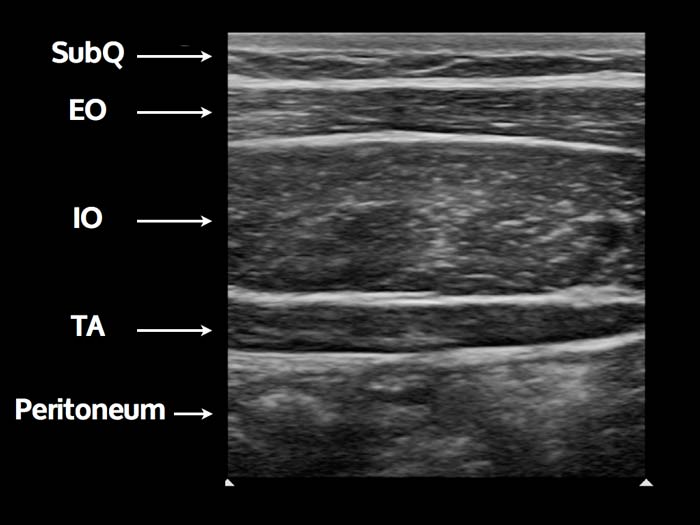Diagnosis: Rectus Sheath Hematoma
This patient had point tenderness in a specific area in the abdomen and had a positive Carnett’s sign, which is exacerbation of pain when the abdominal muscles were tensed.1 Due to the physical exam findings and the fact that this occurred in the setting of exertion, abdominal wall pathology was suspected. While there are many causes of abdominal wall pain,2 this patient’s presentation was more consistent with abdominal muscle pathology. A linear transducer was placed at the point of maximal tenderness and the following clip was obtained:
A large hematoma was uncovered, likely in the setting of an acute internal oblique tear. In order to facilitate an attempt of drainage of the hematoma and to help with pain control, a nerve block of the area was attempted.
- The technique of performing a nerve block of the anterior abdominal wall is called a transversus abdominus plane (TAP) block, and it effectively anesthetizes the skin and muscles of the anterior abdominal wall as well as the parietal peritoneum.3
- In this technique, a linear transducer is placed in a transverse orientation halfway between the iliac crest and the costal margin at the midaxillary line on the side of the injury.
- The following image should be obtained, delineating the 3 different muscles of the anterolateral abdominal wall, the external oblique, internal oblique, and transverses abdominus.4

- Using this technique, 20 mL of 0.25% bupivacaine can be injected between the transversus abdominus and the internal oblique.5 This local anesthetic should spread out and anesthetize the nerves that travel in that plane.
- No serious complications have been described thus far in the medical literature with ultrasound-guided TAP blocks. However, the landmark technique has had reported complications, including bowel and liver injury and femoral nerve palsy.4
The patient had significant pain relief after the TAP block was performed. An 18 gauge spinal needle was used to drain a significant amount of the hematoma. Patient was instructed to follow up with her primary care doctor for further management. The patient was seen around 2 months later, and reported complete resolution of symptoms without any complications from the event.
- Thomson H, Francis DM. Abdominal wall tenderness: a useful sign in the acute abdomen. Lancet 1977;2:1053-4 [pubmed]
- Suleiman S, Johnston DE. The abdominal wall: an overlooked source of pain. Am Fam Physician. 2001;64:431-8 [PDF]
- Charlton S, Cyna A, Middleton P, and Griffiths J. Perioperative transversus abdominis plane (TAP) blocks for analgesia after abdominal surgery. Cochrane Database of Systematic Reviews, vol. 8, Article ID CD007705, 2010. [PDF]
- Herring A, Stone M, Nagdev A. Ultrasound-guided abdominal wall nerve blocks in the ED. Am J Emerg Med 2012;30:759-64 [pubmed]
- Hebbard P, Fujiwara Y, Shibata Y, Royse C. Ultrasound-guided transversus abdominis plane (TAP) block. Anaesth Intensive Care 2007;35(4):616-7. [pubmed]



